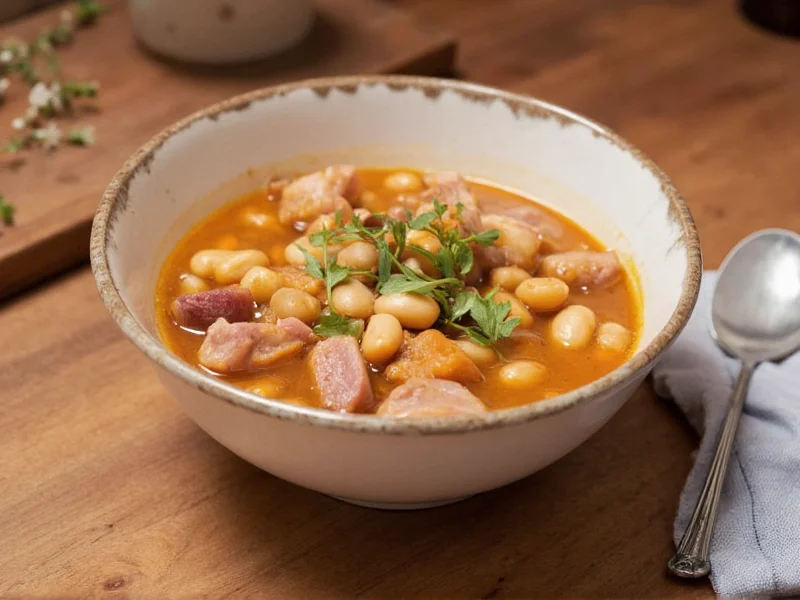Ham hock and bean soup represents one of America's most enduring comfort food traditions, with roots tracing back to European peasant cuisine. This humble dish transforms inexpensive, tough cuts of pork into something extraordinary through the alchemy of slow cooking. The smoked ham hock provides both meat and gelatinous collagen that creates a naturally thickened, velvety broth impossible to replicate with other cuts.
The Essential Components of Authentic Ham Hock Soup
Creating an exceptional ham hock and bean soup requires understanding each component's role. The ham hock isn't merely a flavoring agent—it's the structural foundation that determines the soup's texture and depth. When selecting ham hocks, choose meaty specimens with visible marbling. Both smoked and unsmoked varieties work, though smoked hocks deliver that characteristic bacon-like flavor most associated with traditional recipes.
| Bean Type | Cooking Time | Flavor Profile | Best For |
|---|---|---|---|
| Navy Beans | 60-90 minutes | Mild, slightly sweet | Classic New England style |
| Great Northern | 75-105 minutes | Earthy, robust | Hearty winter versions |
| Cannellini | 70-100 minutes | Creamy, nutty | Mediterranean variations |
| Lima Beans | 65-95 minutes | Buttery, delicate | Southern-style recipes |
Step-by-Step Preparation Guide
Mastering homemade ham hock and bean soup requires attention to timing and technique. Begin by soaking your dried beans overnight in cold water—this crucial step ensures even cooking and reduces digestive discomfort. While some modern recipes skip soaking, traditional preparation never omits this step for optimal texture.
When cooking the ham hock, start it in cold water rather than adding it to boiling liquid. This gradual temperature increase helps extract maximum flavor while keeping the meat tender. Simmer the hock gently for 45 minutes before adding soaked beans—this pre-cooking removes excess salt and impurities. Skim foam regularly during the initial cooking phase for a clearer broth.
The magic happens during the final hour of cooking when the ham hock's collagen breaks down completely, creating that signature silky mouthfeel. Remove the hock when tender enough to pull apart easily, typically after 2-3 hours of total cooking time. Shred the meat, discarding bone and skin, then return it to the pot for serving.
Regional Variations Worth Trying
While the basic ham hock and white bean soup formula remains consistent, regional adaptations offer exciting twists. In the American South, cooks often add a splash of apple cider vinegar at the end to brighten flavors. Northeastern versions frequently include a ham bone along with the hock for extra richness. Some European iterations incorporate smoked paprika or juniper berries for complexity.
For those exploring slow cooker ham hock and bean soup, remember that electric appliances require less liquid than stovetop methods. Reduce water by about 20% to prevent dilution during the extended cooking period. The slow cooker's gentle heat produces exceptionally tender results but requires careful monitoring during the final hour to prevent beans from becoming mushy.
Avoiding Common Preparation Mistakes
Many home cooks make critical errors when preparing this traditional dish. Adding salt too early causes beans to toughen—wait until beans are nearly tender before seasoning. Using canned beans instead of dried creates texture problems; the pre-cooked beans disintegrate during simmering. Another frequent mistake involves rushing the process—ham hock soup needs proper time for flavors to develop fully.
Acidic ingredients like tomatoes or vinegar should join the pot during the last 30 minutes of cooking. Introducing them too early prevents beans from softening properly. If your soup turns out too thin, remove some beans, mash them thoroughly, and stir back into the pot to naturally thicken the broth without flour or cornstarch.
Nutritional Profile and Serving Suggestions
Despite its rich appearance, properly prepared ham hock and bean soup offers surprising nutritional benefits. The combination provides complete protein through the meat-bean synergy, plus substantial fiber from the legumes. While the ham hock contributes fat, most renders out during cooking and can be easily skimmed. For lighter versions, remove visible fat after refrigeration—the solidified fat lifts off cleanly.
Serve this traditional ham hock soup with crusty bread for dipping and a simple green salad. The classic pairing balances the soup's richness while providing textural contrast. Leftovers improve overnight as flavors continue melding—this is one dish that tastes even better the second day. Properly stored in airtight containers, it keeps for up to five days in the refrigerator or three months frozen.











 浙公网安备
33010002000092号
浙公网安备
33010002000092号 浙B2-20120091-4
浙B2-20120091-4